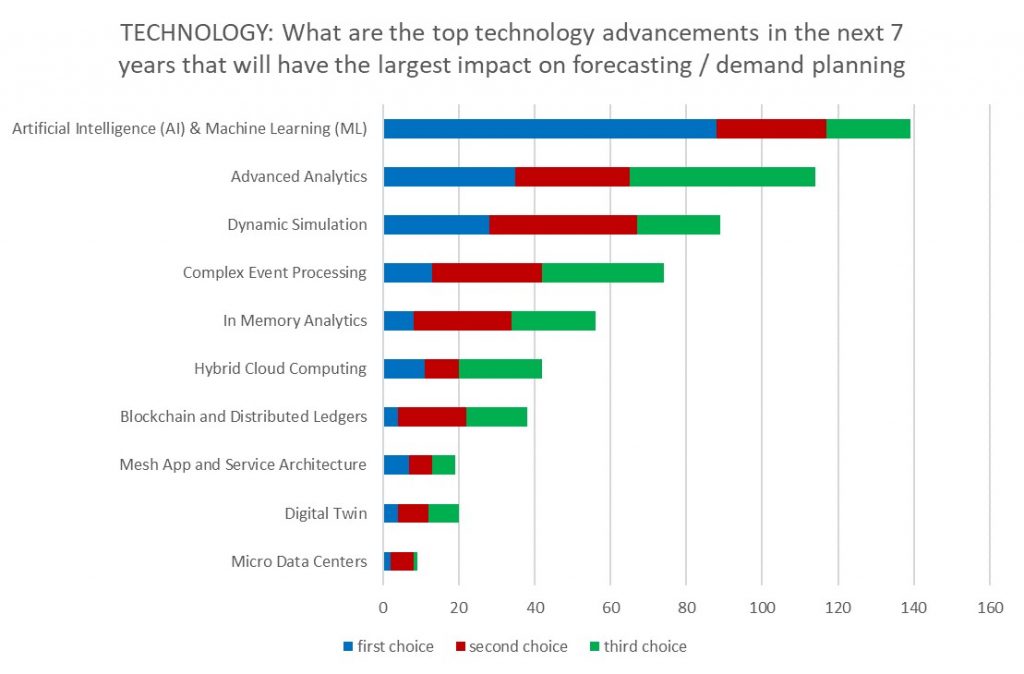While the basic concepts of Machine Learning (ML) and Artificial Intelligence (AI) are not new to forecasting and demand planning, there obviously seems to be renewed interest. For years, forecasters have used algorithms including artificial neural networks, association rules, decision trees, and Bayesian networks – all of which are common methods in Machine Learning. I guess you can say we were data scientists before data science was sexy.
But this is not your daddy’s AI, in part because definitions change over time. Artificial Intelligence is the concept of machines being able to carry out tasks in a way that we would consider “smart”. There was a time when a machine could add 2+2 without humans providing the answer, and that was considered to be smart. Now it deciphers unstructured text analytics in almost real time, tells us directions, makes predictions on our purchase preferences, and even talks to us.
Artificial Intelligence In Demand Planning Has Hit A Tipping Point
Another reason we are seeing this hype about Machine Learning and AI is we have also hit a tipping point. For a while, forecasting and demand planning processes and capabilities were greater than the technology that could support it. Now, we are no longer playing catch up and technology has surpassed planners’ abilities. Because of new technologies, the Machine Learning we see today is not similar to the type of Machine Learning we saw in the past. While many Machine Learning algorithms have been around for a long time, the ability to automatically apply complex mathematical calculations to Big Data – over and over, and at faster speeds – is fairly recent, and is now far, far more advanced.
There is an arms race to leverage both Machine learning and Artificial Intelligence in demand planning solutions
This has lead to an ongoing arms race to leverage both Machine learning and Artificial Intelligence in demand planning solutions more effectively, and in new ways. Interviewing one software provider, they stated that almost all their research dollars going forward are tied to these technologies. All of this makes one pause and think that if we have come this far today, where will we be tomorrow?
IBF’s Survey Results Are In – Here’s What You Said
Last year the Institute of Business Forecasting (IBF) conducted our own research and asked demand planning and forecasting professionals how they saw their roles tomorrow. These questions were to measure how practitioners saw the discipline of demand planning in the year 2025 in regard to people, process, and technology. [Ed: this is the final in a series of articles discussing the results – other survey insights can be found regarding PEOPLE and PROCESS]
To help gauge the future of technology, we asked “What are the top technology advancements in the next 7 years that will have the largest impact on forecasting and demand planning?” Not surprisingly, of the 200-plus respondents, close to 70% of them answered Artificial Intelligence and Machine Learning as either their first, second, or third choice. Other key takeaways were dynamic simulation with 14% of first choices and blockchain (just making the list with only 2% of first choices).We are seeing these and other similar trends begin to emerge today.

70% of respondents considered AI and Machine Learning to be the most important technological advancement in 2025.
The Real Applications Of AI and Machine Learning Today
Research just released, conducted by Forrester Consulting and commissioned by Ivalua, revealed that 55% of organizations are set to make a major investment in Artificial Intelligence over the next two years. With applications using Artificial Intelligence and Machine Learning, algorithms can learn by taking the output of an application like a forecast and examining that output against some measure of the truth, and then adjusting the parameters involved in generating the output forecast, and seeing if the adjustments lead to more accurate outputs. Technology should also help liberate current demand planners away from rote SKU monitoring, toward more complex tasks, such as algorithm generation for the automated technology.
Starbucks will now generate serving recommendations for customers approaching their stores
Companies like Merck can change forecasts immediately based on far-off events, like hospital fires or natural disasters, that could impact demand for pharmaceuticals. Starbucks will now generate serving recommendations for customers approaching their stores, using location data to know when customers approach. One large CPG company is now considering lights-out statistical forecasting and re-deploying its demand planers to new value-added roles being more collaborative and supporting multiple functions and predictive analytics needs.
The research findings are taken from Institute of Business Forecasting’s (IBF) on-line survey “Future of Demand Planning and Forecasting”, conducted between September 1st 2017 and October 24th 2017. The findings were discussed in the Winter 2017 issue of The Journal of Business Forecasting. Click the link to download.
If you would like to contribute an article to Demand-Planning.com, submit your details and suggested topics to the editorial team here.

